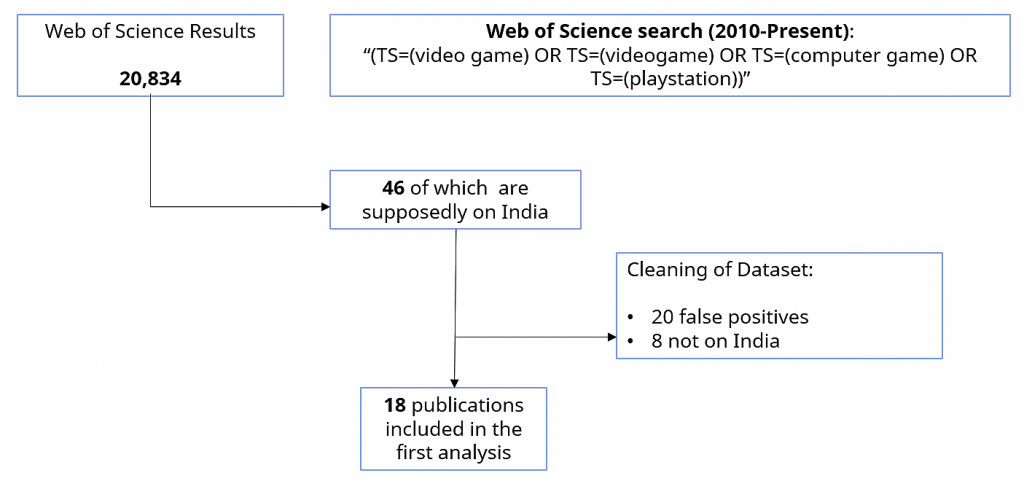
Until 2010, there were 20 million users in the budding video gaming industry of India. By 2020, this number saw a whopping 22x rise, with 450 million users playing a wide range of casual, hyper-casual, classic, mid-core, and hardcore games. In the last five years, the industry has seen phenomenal development and is predicted to triple in value to US $3.9 billion by 2025.
The global academic research has focused on understanding the boom in video games, representation of gender, race, and post-coloniality, the educative potential of video gaming and their adverse consequences on violence and aggression. Many have offered recommendations for game designers to ensure inclusivity, or to governments and video game players regarding means of regulation like parental control, time constraints, and warning messages. Despite the massive popularity of video games all across India, there is a surprising dearth of research in the fields of evolution of the video game industry and in-depth analysis of video games and policy interventions. With the rapid rise in the video gaming industry in India, research on its construction, implications and possible interventions is necessary going forward so that video game makers in India are encouraged to offer new and inclusive platforms of gaming moving away from relying heavily on existing popular games, violence, and stereotypes. Research can also help understand the role that governments and technology policy can play in regulating and encouraging constructive video gaming in the Indian context specifically. Using bibliometric analysis, this article highlights the paucity of academic research in the video gaming landscape in India; themes and shortcomings in the existing literature and proposes scope for newer and more holistic research. However, other types of popular and credible research (mainly market research and industry reports by consulting firms) are not covered in this article since they do not fit under the purview of a scientific research article.
While research on popular culture and mainstream media such as movies, books, music, TV series has gained traction in India in the last few decades, video games continue to remain an under-researched caveat. Critical analysis of pop culture is often used to understand shift in cultural and ideological narratives in the nation and when woven with critiques of gender, class, and caste reveal the pulse of the people. Video games offer a novel insight into analysis of cultural consumption, because they actively encourage the user's participation in their ecosystem. Unlike films, music, and television series, the players are often invited (albeit in limited ways) to frame their own stories and choose their actions, avatars, and teams. Players embody the characters in the games, and their powers and responsibilities. This active participation in fixed designed environments (in games like Clash of Clans) or in self-created ones (in games like Second Life) can bring out interesting insights into what kinds of games people like to play, characters they like to embody, and who is left out or stereotyped and why. Numerous studies highlight the power of embodiment and complete immersion in video game narratives, and what it can do to its players. While some study the educational potential of this hands-on experience and how it can be employed constructively, many others fear an increase in violence and apathy of players who engage in aggressive and militant games.
Bibliometric Analysis findings
The method of bibliometric analysis was adopted for its ability to handle large amounts of scientific literature and its potential for statistical analysis. A keyword search of title and abstract on Web of Science was used to find existing publications from 2010 onwards. Scientific literature with a focus on video games, computer games, and play-station was filtered.
Figure 1: Bibliometric analysis shows a lack of research on video games for the Indian context
Retrieval of research articles using Web of Science Database
 Articles from January 2010 to January 2022; Analysis by CPC Analytics.
Articles from January 2010 to January 2022; Analysis by CPC Analytics.
Within the specified time frame, the search yielded a dataset of 20,834 articles. The search term was further adjusted to include publications on India (as a country of study). Only 46 articles (0.22 percent) were retrieved. After thorough inspection of those publications, the final dataset only contained 18 research articles concerning video gaming in India. This means that out of every 1,200 articles written worldwide, just one is on India. This shows that despite the exponential growth of video game users in India, research has not caught up with the changes it may bring to its young users. The manual verification showed that eight out of the 46 articles were falsely attributed to India, while 20 were false positives (main focus not on video games). A high number of false positives were a product of non-refinement of keyword search, so that we don’t miss out on relevant articles.
Themes and Gaps Emerging from Existing Literature on India
The bibliometric analysis allowed us to classify existing literature in relevant themes. As can be seen in fig.2, most of the papers focus on impacts on physical and mental health. Such studies are invested in the effects of video gaming on its most important stakeholder: Its players. Researchers highlight the negative impacts of constantly sitting in front of digital screens on weight, eyesight, and overall wellbeing of the body. Many others note an increase in aggression, fallen attention s and de-sensitivity to real-life violence of school going children who regularly play violent video games. Some also study the addiction of children to video gaming.
Figure 2: Scarce Policy-based research in the Indian Video gaming landscape
Thematic categorisation of articles on India, 2010-2022
 Data Source: Web of Science. N=20,834. Articles on India: 18. Theme Count: 33; Manual Categorization.
Data Source: Web of Science. N=20,834. Articles on India: 18. Theme Count: 33; Manual Categorization.
Note: 1 article may fall under more than 1 theme; Analysis by CPC Analytics.
Education is another commonly studied theme. The educative potential of video gaming, and how it can be used to stimulate creativity and concept clarity in students is addressed. A less commonly researched niche is the study of gender and race in video games in India. Many researchers play selected games at length and note the construction of different genders (if there are any), the rampant sexism and voyeurism on women's bodies. In Indian studies, racism is studied through the lens of post-colonial masculinities and fetishisation of white women. However, the games studied are 'casual' or 'hyper-casual games' (games with a nearly flat learning curve, no time constraints and simple mechanics), and not 'hard-core' ones (games which require high engagement and investment of time and learning). The cultural dissonance in Indian audiences which comes with playing games which are set in imperial contexts or other countries is under-researched. Indian origin games, on the other hand, use the prominence of such games to market their 'Indian-ness' and claim to speak to the 'Indian' people with their religious and mythological tropes. However, and predictably so, they echo casteist themes of dominant Hindu stories and mythological characters, and invisibilise other narratives. For instance, a popular Indian game called Raji, which won various prestigious awards employs the narrative of Goddess Durga killing Mahishasura, who is portrayed as a demon in the mainstream media. This portrayal is ignorant of his role as a god figure for various lower caste communities. This raises questions about which 'Indian-ness' is considered legitimate in popular culture and who are the makers behind it.
From 2010, we did not come across a single research article in the Web of Science addressing policy construction or intervention for video games. This is surprising, because many other countries had begun to come up with prospective regulations for controlling violence, bad representation and children's use of video games. This can be attributed to the fact that video games were not as commonplace in India during the time, and the focus of regulation was limited to cyber-bullying and pornography. However, in the context of the pandemic and sharp spurt in video gaming, now is the ripe time for coming up with prospective interventions in the landscape to encourage quality design, production, and use of video games.
Conclusion
The internet and digital technology has affected the lives of all of us, and reached even in some of the most rural parts of the world. In this context, gaming has become potent site of action in India, with more than 450 million gamers clocking in more and more hours playing. The attraction to violent and stereotypical narratives and implications of engagement with them have not been studied enough, especially in 'hard-core' games which employ extensive narrative building. Besides this, the focus on policy and intervention is virtually non-existent, except in a few contexts like fantasy sports and gambling games, which have only been introduced recently. In fact, only 0.22 percent of articles in the gaming industry from 2010 till date were on India. We argue that an in-depth analysis (analysis which is done by immersing in the game and noting its particular characteristics, understanding how the gender, race, caste, violence, and other identities are represented) of some of the most commonly played 'hard-core' games in India is missing, and will yield novel insights for not just policymakers, but also video game developers, players, and other stakeholders in the video gaming landscape like parents and teachers. Some of the stakeholders who are conducting extensive industry research are video game developers and firms such as KPMG in the international private industry research sector. Indian academia, think tanks, and consultancy firms must also progressively encourage advanced research in India.
The authors would like to acknowledge Laslo Jaeger and Pragya Narayanan for their contribution to the research.
The views expressed above belong to the author(s). ORF research and analyses now available on Telegram! Click here to access our curated content — blogs, longforms and interviews.






 PREV
PREV




